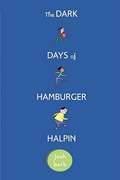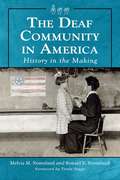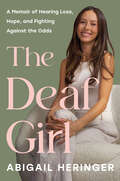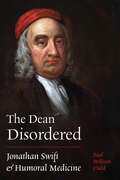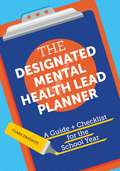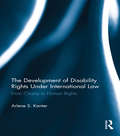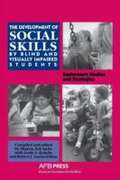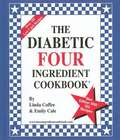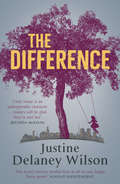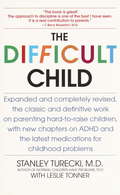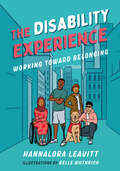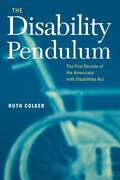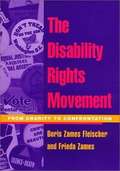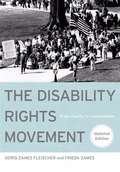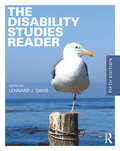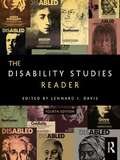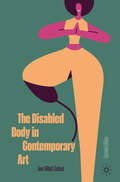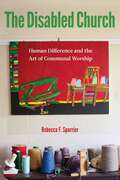- Table View
- List View
The Dark Days of Hamburger Halpin
by Josh Berk<P>Being a hefty, deaf newcomer almost makes Will Halpin the least popular guy at Coaler High. But when he befriends the only guy less popular than him, the dork-namic duo has the smarts and guts to figure out who knocked off the star quarterback. Will can't hear what's going on, but he's a great observer. So, who did it? And why does that guy talk to his fingers? And will the beautiful girl ever notice him? (Okay, so Will's interested in more than just murder . . . ) <P>Those who prefer their heroes to be not-so-usual and with a side of wiseguy will gobble up this witty, geeks-rule debut.
The Deaf Community in America: History in the Making
by Melvia Nomeland Ronald NomelandThe deaf community in the West has endured radical changes in the past centuries. This work of history tracks the changes both in the education of and the social world of deaf people through the years. Topics include attitudes toward the deaf in Europe and America and the evolution of communication and language. Of particular interest is the way in which deafness has been increasingly humanized, rather than medicalized or pathologized, as it was in the past. Successful contributions to the deaf and non-deaf world by deaf individuals are also highlighted. Instructors considering this book for use in a course may request an examination copy here.
The Deaf Girl: A Memoir of Hearing Loss, Hope, and Fighting Against the Odds
by Abigail HeringerAn inspiring story of hearing loss and hope from The Bachelor's first deaf contestantAbigail Heringer made her television debut as an instant fan-favorite on season 25 of The Bachelor. Stepping out of the limousine, she approached her bachelor with a playful declaration: she would be staring at his lips all night for two compelling reasons—her profound deafness since birth and because he had some nice lips!But Abigail's journey wasn't always marked by such confidence. Growing up deaf and introverted, she dreaded being the center of attention, fearing her disability would burden those around her. Among her hearing peers, she felt like an outsider, simply labeled as "the deaf girl." And after receiving a cochlear implant at the age of two, she subsequently struggled to find her place in the Deaf community too. Caught in between two worlds and grappling to define her identity as a deaf woman, Abigail felt like she belonged in neither.Supported by her family, particularly her deaf older sister Rachel, Abigail has come to understand that while being deaf is part of her identity, it doesn't define her. Throughout her journey, marked by challenges and adversity, Abigail has grown into her own strongest advocate, discovering a new voice that is confident, fearless, and empowered—a voice that enables her to proudly reclaim the title of "the deaf girl" she once resisted and rewrite it as a testament to her resilience and strength.Hopeful, vulnerable, and uplifting, The Deaf Girl shares Abigail's journey of navigating life with a profound hearing loss and her transformation from merely accepting her disability to embracing it wholeheartedly. This memoir serves as an inspiring reminder for anyone who has ever felt like an outsider or struggled to embrace their differences, showcasing that every voice is worthy of being heard.
The Deaf Musicians
by Pete Seeger Paul Dubois JacobsLee is a piano man. Every night, he plays jazz for the crowd. It sounds something like this:<P><P> Plink-a-plink-BOMP-plink-plink.<P> Yimba-timba-TANG-ZANG-ZANG.<P> One night, Lee's bandmates notice something is off. Lee's music comes out like this:<P> Ronk. Phip. Tonk.<P> There's no way to hide it: Lee is losing his hearing. Then Lee discovers sign language. And soon after, he meets Max, who plays the sax. Together they form a new band-the Deaf Musicians. But who will listen to a deaf musician? <P> With The Deaf Musicians, Pete Seeger, Paul DuBois Jacobs, and three-time Coretta Scott King Honor winner R. Gregory Christie present an inspiring story of overcoming obstacles, set to a jazzy score.<P> OO-AH, BE-DOOP, BE-DOOP, OO-AH, YEAH!<P> Winner of the Schneider Family Book Award
The Dean Disordered: Jonathan Swift and Humoral Medicine (Peculiar Bodies)
by Paul William ChildUnderstanding Jonathan Swift&’s medical and literary lifeThe Dean Disordered bridges biography and literary criticism to examine the chronic afflictions suffered by the great Irish satirist Jonathan Swift, investigating not only how these ailments affected his day-to-day social life and ambitions but also how he represented them in his correspondence and imaginative writings. By historicizing Swift&’s medical issues, Paul William Child returns the creator of the iconic character of Gulliver (a surgeon, notably) to the humoral body that he knew. Child situates Swift&’s complaints within the theory of illness as an imbalance of fluid humors that had persisted since classical days, considering how Swift tried to make sense of and contain his own humors through narrative explanation, medical interventions and regimen, performances in the &“sick role,&” and imaginative representations. Rather than accepting modern diagnoses of Swift&’s illnesses, The Dean Disordered reconstructs the medical culture of his time. The book opens a window into Swift&’s experience of illness and prompts us to read both the man and his works anew.
The Demography and Causes of Blindness
by Hyman GoldsteinA report on the statistics of blindness from an international point of view.
The Demography of Blindness Throughout the World
by Hyman Goldstein<P>Most of the world's blindness could be prevented, and the attack on it and its consequences proceeds apace through such organizations as the World Council for the Welfare of the Blind, the International Agency for the Prevention of Blindness, and the World Health Organization. <P>For greatest effectiveness, their programs must be based upon accurate data, as a WHO study quoted here by Dr. Goldstein makes clear: "In order to establish appropriate priorities for prevention and treatment at the national and international level, it is essential that reliable up-to-date statistical data on prevalence, age of onset, and causes of blindness be obtained." <P>But even in the United States, where collection of data on blindness began in 1830, there are still no reliable trend data. In much of the rest of the world data are fragmentary, and data that would allow valid country by country comparisons are almost non-existent. <P>Dr. Goldstein has done a valuable service in pulling together such statistics as can be found, and in discussing their weaknesses and strengths.
The Designated Mental Health Lead Planner: A Guide and Checklist for the School Year
by Clare ErasmusThis planner provides detailed guidance on what a Designated Mental Health Lead needs to do, when they need to do it, and how they can achieve the best results. It gives a clear focus and checklist for each week, including spaces to add your own to-do list, and encourages reflection on the outcomes and impact of your actions on pupils' attainment and wellbeing. It also encourages a focus on your own development and self-care, with space to record what you are currently reading or listening to and one thing you are grateful for that week.In addition to the termly and weekly plans, the book provides short briefs on key aspects of the role, including how to work effectively with teachers, the HR team, the DSL, governors, the pastoral team, Mental Health Support Teams and parents. It is an invaluable resource for all DMHLs tackling the 39 academic weeks.
The Development of Disability Rights Under International Law: From Charity to Human Rights
by Arlene S. KanterThe adoption of the Convention on the Rights of People with Disabilities (CPRD) by the United Nations in 2006 is the first comprehensive and binding treaty on the rights of people with disabilities. It establishes the right of people with disabilities to equality, dignity, autonomy, full participation, as well as the right to live in the community, and the right to supported decision-making and inclusive education. Prior to the CRPD, international law had provided only limited protections to people with disabilities. This book analyses the development of disability rights as an international human rights movement. Focusing on the United States and countries in Asia, Africa, the Middle East the book examines the status of people with disabilities under international law prior to the adoption of the CPRD, and follows the development of human rights protections through the convention’s drafting process. Arlene Kanter argues that by including both new applications and entirely new approaches to human rights treaty enforcement, the CRPD is significant not only to people with disabilities but also to the general development of international human rights, by offering new human rights protections for all people. Taking a comparative perspective, the book explores how the success of the CRPD in achieving protections depends on the extent to which individual countries enforce domestic laws and policies, and the changing public attitudes towards people with disabilities. This book will be of excellent use and interest to researchers and students of human rights law, discrimination, and disability studies.
The Development of Social Skills by Blind and Visually Impaired Students: Exploratory Studies and Strategies
by Sharon Zell Sacks Linda S. Kekelis Robert J. Gaylord-RossThe book, using an ethnographic approach, outlines the theoretical background of social-skills development, presents case studies and suggests guidelines for helping Blind and Visually Impaired children shape those encounters into satisfying ones.
The Diabetic Four Ingredient Cookbook
by Linda Coffee Emily CaleFrom the back cover: Diabetics and Health-minded People-Take Note! If you are trying to eat a healthier diet because of diabetes or just because you know it is the best decision for you, but you are struggling with limited time or energy . . . this cookbook is a lifesaver! This new large print edition, The Diabetic Four Ingredient Cookbook, is a practical kitchen tool for busy cooks who must or want to eat healthy. Over 150 new recipes have been added. Each simple recipe provides the nutritional analysis, along with the exchanges. There are also more than 180 recipes that are low in carbohydrates and easily located by the Low Carb next to the recipe name. This book is full of delicious, easy recipes!
The Difference
by Justine Delaney WilsonOn a January morning, Beth and Steve bring three-day-old Ismae home from the hospital. A little girl to complete their suburban family.Except Beth knows that Ismae is different. And that, as she gets older and stronger, her difference will become more obvious.As the future Beth imagined grows even more out of reach, the walls of their vast house close in on her, isolating her from Steve.Then she makes a terrible discovery ...Will Ismae's difference break her family apart? Or will Beth be able to see that it's the one thing that can save her?'Little Ismae is an unforgettable character ... readers will be glad they've met her'BELINDA McKEON 'A novel about one woman's quest for an authentic life. When extraordinary new baby Ismae turns Beth's world inside out, she begins to understand the fierce power of mother-love and,through her daughter, learns to know and trust herself. A moving, convincing story of courage and burgeoning hope' NUALA O'CONNOR, AUTHOR OF MISS EMILY
The Difficult Child
by Stanley Turecki Leslie TonnerHow to help--and cope with--the difficult childExpanded and completely revised, the classic and definitive work on parenting hard-to-raise children with new sections on ADHD and the latest medications for childhood disorders.Temperamentally difficult children can confuse and upset even experienced parents and teachers. They often act defiant, stubborn, loud, aggressive, or hyperactive. They can also be clingy, shy, whiny, picky, and impossible at bedtime, mealtimes, and in public places. This landmark book has been completely revised to include the latest information on ADHD, medications, and a reassuring approach to all aspects of childhood behavioral disorders.In this parenting classic, Dr. Stanley Turecki, one of the nation's most respected experts on children and discipline--and himself the father of a once difficult child--offers compassionate and practical advice to parents of hard-to-raise children. Based on his experience with thousands of families in the highly successful Difficult Children Program he developed for Beth Israel Medical Center in New York City, his step-by-step approach shows you how to: Identify your child's temperament using a ten-point test to pinpoint specific difficulties Manage common--often "uncontrollable"--conflict situations expertly and gently Make discipline more effective and get better results with less punishment Get support from schools, doctors, professionals, and support groups Understand ADHD and other common diagnoses, and decide if medication is right for your child Make the most of the tremendous potential and creativity that many "difficult" children haveDrawing on his experience with thousands of families in his highly successful Difficult Child Program, Dr. Turecki shows parents how to:Identify their child's difficult temperament using a ten-point test to pinpoint specific difficultiesManage typical conflict situations expertly and kindlyMake discipline more effective and get better results with less punishmentGet support from schools, doctors, and others Understand ADHD and other common diagnoses, and decide whether medication is right for their childMake the most of the child's creativity and potential -->From the Trade Paperback edition.
The Difficult Child: Expanded and Revised Edition
by Stanley Turecki Leslie TonnerHow to help--and cope with--the difficult childExpanded and completely revised, the classic and definitive work on parenting hard-to-raise children with new sections on ADHD and the latest medications for childhood disorders.Temperamentally difficult children can confuse and upset even experienced parents and teachers. They often act defiant, stubborn, loud, aggressive, or hyperactive. They can also be clingy, shy, whiny, picky, and impossible at bedtime, mealtimes, and in public places. This landmark book has been completely revised to include the latest information on ADHD, medications, and a reassuring approach to all aspects of childhood behavioral disorders.In this parenting classic, Dr. Stanley Turecki, one of the nation's most respected experts on children and discipline--and himself the father of a once difficult child--offers compassionate and practical advice to parents of hard-to-raise children. Based on his experience with thousands of families in the highly successful Difficult Children Program he developed for Beth Israel Medical Center in New York City, his step-by-step approach shows you how to: Identify your child's temperament using a ten-point test to pinpoint specific difficulties Manage common--often "uncontrollable"--conflict situations expertly and gently Make discipline more effective and get better results with less punishment Get support from schools, doctors, professionals, and support groups Understand ADHD and other common diagnoses, and decide if medication is right for your child Make the most of the tremendous potential and creativity that many "difficult" children haveDrawing on his experience with thousands of families in his highly successful Difficult Child Program, Dr. Turecki shows parents how to:Identify their child's difficult temperament using a ten-point test to pinpoint specific difficultiesManage typical conflict situations expertly and kindlyMake discipline more effective and get better results with less punishmentGet support from schools, doctors, and others Understand ADHD and other common diagnoses, and decide whether medication is right for their childMake the most of the child's creativity and potential -->From the Trade Paperback edition.
The Disability Bioethics Reader
by Joel Michael Reynolds Christine WieselerThe Disability Bioethics Reader is the first introduction to the field of bioethics presented through the lens of critical disability studies and the philosophy of disability. Introductory and advanced textbooks in bioethics focus almost entirely on issues that disproportionately affect disabled people and that centrally deal with becoming or being disabled. However, such textbooks typically omit critical philosophical reflection on disability. Directly addressing this omission, this volume includes 36 chapters, most appearing here for the first time, that cover key areas pertaining to disability bioethics, such as: state-of-the-field analyses of modern medicine, bioethics, and disability theory health, disease, and the philosophy of medicine issues at the edge- and end-of-life, including physician-aid-in-dying, brain death, and minimally conscious states enhancement and biomedical technology invisible disabilities, chronic pain, and chronic illness implicit bias and epistemic injustice in health care disability, quality of life, and well-being race, disability, and healthcare justice connections between disability theory and aging, trans, and fat studies prenatal testing, abortion, and reproductive justice. The Disability Bioethics Reader, unlike traditional bioethics textbooks, also engages with decades of empirical and theoretical scholarship in disability studies—scholarship that spans the social sciences and humanities—and gives serious consideration to the history of disability activism.
The Disability Experience: Working Toward Belonging (Orca Issues #5)
by Hannalora LeavittPeople with disabilities (PWDs) have the same aspirations for their lives as you do for yours. The difference is that PWDs don’t have the same access to education, employment, housing, transportation and healthcare in order to achieve their goals. In The Disability Experience you’ll meet people with different kinds of disabilities, and you'll begin to understand the ways PWDs have been ignored, reviled and marginalized throughout history. The book also celebrates the triumphs and achievements of PWDs and shares the powerful stories of those who have fought for change.
The Disability Pendulum: The First Decade of the Americans With Disabilities Act (Critical America #39)
by Ruth ColkerSigned into law in July 1990, the Americans with Disabilities Act (ADA) became effective two years later, and court decisions about the law began to multiply in the middle of the decade. In The Disability Pendulum, Ruth Colker presents the first legislative history of the enactment of the ADA in Congress and analyzes the first decade of judicial decisions under the act. She assesses the success and failure of the first ten years of litigation under the ADA, focusing on its three major titles: employment, public entities, and public accommodations.The Disability Pendulum argues that despite an initial atmosphere of bipartisan support with the expectation that the ADA would make a significant difference in the lives of individuals with disabilities, judicial decisions have not been consistent with Congress’ intentions. The courts have operated like a pendulum, at times swinging to a pro-disabled plaintiff and then back again to a pro-defendant stance. Colker, whose work on the ADA has been cited by the Supreme Court, offers insightful and practical suggestions on where to amend the act to make it more effective in defending disability rights, and also explains judicial hostility toward enforcing the act.
The Disability Rights Movement (Cornerstones of Freedom)
by Deborah KentAccording to 1990 census figures, about 43 million Americans, or one person out of every seven, have some form of disability. A disability is defined as any condition that limits a person's capacity to work or to perform tasks of daily living such as dressing, bathing, cooking, driving an automobile, or using a telephone. Judy Heumann, Paul Miller, and Ruth Sienkiewicz have widely varied disabling conditions. Yet they share one common bond. Each of them experienced the pain of discrimination. Though many challenges lie ahead, people with disabilities are becoming more visible on the streets, in the workplace, and in the media.
The Disability Rights Movement: From Charity To Confrontation
by Doris Z. Fleischer Freida Zames<P>Based on interviews with almost a hundred activists, this book provides a detailed history of the struggle for disability rights in the United States. It is a complex story of shifts in consciousness and shifts in policy, of changing focuses on particular disabilities such as blindness, deafness, polio, quadriplegia, psychiatric and developmental disabilities, chronic conditions (for example, cancer and heart disease), AIDS, and of activism and policymaking across disabilities. <P>Referring to the Americans with Disabilities Act as "every American's insurance policy," the authors recount the genesis of this civil rights approach to disability, from the almost forgotten disability activism of the 1930s, to the independent living movement of the 1970s, to the call for disability pride of the 1990s. Like other civil rights struggles, the disability rights movement took place in the streets and in the courts as activists fought for change in the schools, the workplace, and in the legal system. They continue to fight for effective access to the necessities of everyday life-to telephones, buses, planes, public buildings, restaurants, and toilets. <P>The history of disability rights mirrors the history of the country. Each World War sparked changes in disability policy and changes in medical technology as veterans without limbs and with other disabilities returned home. The empowerment of people with disabilities has become another chapter in the struggles over identity politics that began in the 1960s. <P>Today, with the expanding ability of people with disabilities to enter the workforce and a growing elderly population, issues like longterm care are becoming increasingly significant at a time when HMOs are trying to contain health care expenditures.
The Disability Rights Movement: From Charity to Confrontation, Updated Edition
by Frieda Zames Doris Zames FleischerA newly updated account of the struggle for disability rights in the U.S.
The Disability Studies Reader
by Lennard J. DavisDisability studies has gone from being a relatively unknown field to one of increasing importance in the social sciences. The sixth edition of The Disability Studies Reader brings in new topics, scholars, writers, artists, and essays to address links between ableism and imperialism; disability bioethics; and the relationship between disability agency, social policy, and decarceration. There are as many meanings and experiences of disability as there are disabled people, and this diversity ensures that the work of the field will continue to evolve. Fully revised and brought up to date, this volume addresses a wider range of geographical and cultural contexts, and many pay specific attention to the intersections between disability and race, gender, and sexuality. The growing interest and activism around the issue of neuroatypicality is also reflected in a new section on neurodivergence. The Disability Studies Reader remains an excellent touchstone for students in disability studies courses across the disciplines, including the social sciences, English literature, and psychology.
The Disability Studies Reader
by Lennard J. DavisThe fifth edition of The Disability Studies Reader addresses the post-identity theoretical landscape by emphasizing questions of interdependency and independence, the human-animal relationship, and issues around the construction or materiality of gender, the body, and sexuality. Selections explore the underlying biases of medical and scientific experiments and explode the binary of the sound and the diseased mind. The collection addresses physical disabilities, but as always investigates issues around pain, mental disability, and invisible disabilities as well. Featuring a new generation of scholars who are dealing with the most current issues, the fifth edition continues the Reader’s tradition of remaining timely, urgent, and critical.
The Disability Studies Reader, 4th Edition
by Lennard J. DavisThe Fourth Edition of the Disability Studies Reader breaks new ground by emphasizing the global, transgender, homonational, and posthuman conceptions of disability. Including physical disabilities, but exploring issues around pain, mental disability, and invisible disabilities, this edition explores more varieties of bodily and mental experience. New histories of the legal, social, and cultural give a broader picture of disability than ever before. Now available for the first time in eBook format 978-0-203-07788-7.
The Disabled Body in Contemporary Art
by Ann Millett-GallantThe second edition offers an essential update to the foundational first edition, The Disabled Body in Contemporary Art. Featuring updated chapters and case studies, this second edition will not only expand on the first edition but will bring a new focus to contemporary disabled artists and their embodied, multimedia work.
The Disabled Church: Human Difference and the Art of Communal Worship
by Rebecca F. SpurrierHow do communities consent to difference? How do they recognize and create the space and time necessary for the differences and disabilities of those who constitute them? Christian congregations often make assumptions about the shared abilities, practices, and experiences that are necessary for communal worship. The author of this provocative new book takes a hard look at these assumptions through a detailed ethnographic study of an unusual religious community where more than half the congregants live with diagnoses of mental illness, many coming to the church from personal care homes or independent living facilities. Here, people’s participation in worship disrupts and extends the formal orders of worship. Whenever one worships God at Sacred Family Church, there is someone who is doing it differently.Here, the author argues, the central elements and the participation in the symbols of Christian worship raise questions rather than supply clear markers of unity, prompting the question, What do you need in order to have a church that assumes difference at its heart?Based on three years of ethnographic research, The Disabled Church describes how the Sacred Family community, comprising people with very different mental abilities, backgrounds, and resources, sustains and embodies a common religious identity. It explores how an ethic of difference is both helped and hindered by a church’s embodied theology. Paying careful attention to how these congregants improvise forms of access to a common liturgy, this book offers a groundbreaking theology of worship that engages both the fragility and beauty revealed by difference within the church. As liturgy requires consent to difference rather than coercion, an aesthetic approach to differences within Christian liturgy provides a frame for congregations and Christian liturgists to pay attention to the differences and disabilities of worshippers. This book creates a distinctive conversation between critical disability studies, liturgical aesthetics, and ethnographic theology, offering an original perspective on the relationship between beauty and disability within Christian communities. Here is a transformational theological aesthetics of Christian liturgy that prioritizes human difference and argues for the importance of the Disabled Church.
